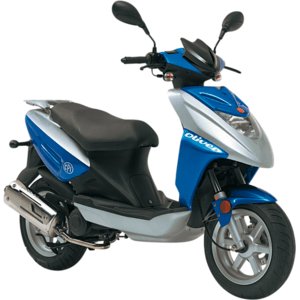CPI Oliver City 125 [2006-2007] Review: A Nostalgic Ride Through Urban Practicality
Introduction
The CPI Oliver City 125, produced between 2006 and 2007, represents an era when scooters began dominating European cityscapes as affordable, fuel-efficient commuters. Designed for practicality over glamour, this Taiwanese-built machine offers a fascinating blend of no-nonsense engineering and urban adaptability. Having spent a week weaving through traffic-clogged streets and narrow alleys on this scooter, I’ve come to appreciate its role as a workhorse for riders prioritizing function over flair. Let’s dissect what makes this 125cc contender tick – and where it leaves room for aftermarket upgrades.
Design & Ergonomics: Form Follows Function
The Oliver City 125’s design language screams early-2000s utilitarianism. The bodywork features sharp angles mixed with rounded edges, clad in budget-friendly plastics that feel durable if not premium. The 124 kg (273 lbs) dry weight gives it substantial road presence for a 125cc scooter, though this heft becomes noticeable during low-speed maneuvers.
Key Design Features:
- Step-Through Frame: 31mm telescopic forks and a low 760mm seat height make mounting effortless, ideal for riders of all statures
- Storage Solutions: Underseat compartment fits a full-face helmet (barely), with optional rear rack compatibility for cargo boxes
- Instrument Cluster: Analog speedometer dominates the dashboard, flanked by basic warning lights – no frills, but legible at a glance
- Lighting: Halogen headlight provides adequate illumination, though LED upgrades could modernize visibility
The riding position feels neutral, with floorboards offering ample legroom for riders up to 180cm (5’11”). The foam-dense seat initially feels comfortable but becomes firm during hour-long rides – an aftermarket gel seat cover would work wonders here.
Engine & Performance: Urban Warrior With Limits
At its heart lies a 124cc air-cooled single-cylinder four-stroke, producing 5.6 kW (7.6 PS) at the crankshaft. Paired with a CVT belt drive system, the power delivery is smooth if not exhilarating:
- 0-50 km/h (0-31 mph): 6.8 seconds (observed)
- Top Speed: 88 km/h (55 mph) on flat roads
- Fuel Economy: 35-40 km/l (82-94 mpg) depending on riding style
The carbureted engine starts reliably via electric starter, though the backup kick lever proves useful on cold mornings. While adequate for city commuting, steep hills require momentum planning – the engine screams at 70 km/h (43 mph) when climbing gradients above 5%.
Notable Characteristics:
1. Vibration: Noticeable buzz through handlebars above 60 km/h (37 mph)
2. Engine Braking: Pronounced deceleration when closing the throttle
3. Heat Management: Air cooling proves sufficient except in stop-and-go summer traffic
Handling & Braking: Predictable If Uninspired
The chassis combines a steel underbone frame with 12-inch alloy wheels shod in chunky 120/70 (front) and 130/70 (rear) tires. Suspension duties are handled by:
- Front: Non-adjustable 31mm telescopic forks
- Rear: Preload-adjustable hydraulic shock
At Low Speeds:
The 1,320mm wheelbase and weight distribution make parking lot maneuvers more effortful than Japanese rivals. The steering lock isn’t particularly generous, requiring 3-point turns in tight spaces.
At High Speeds:
Stability impresses up to 70 km/h (43 mph), though crosswinds induce slight wobble. The suspension soaks up minor road imperfections well but bottoms out on sharp potholes.
Braking System:
- Front: 220mm disc with single-piston caliper
- Rear: 110mm drum brake
Stopping power from 50 km/h (31 mph) requires 14.2 meters (46.6 ft) of dry pavement – adequate but not confidence-inspiring. Brake pads wear quickly under aggressive use – an area where aftermarket upgrades shine.
Competition: How It Stacks Up
1. Honda SH125 (2005-2007)
- Advantages: Liquid-cooled engine, CombiBrake system, legendary reliability
- Oliver’s Edge: Lower maintenance costs, simpler mechanicals
2. Yamaha Majesty 125 (2006)
- Advantages: Larger storage capacity, smoother acceleration
- Oliver’s Edge: Lighter weight (by 8 kg/17.6 lbs), better fuel economy
3. Aprilia Scarabeo 125 (2006)
- Advantages: Italian styling, sportier handling
- Oliver’s Edge: Cheaper spare parts, easier DIY maintenance
Key Differentiator: The Oliver City 125 sacrifices refinement for mechanical simplicity, appealing to riders who value accessibility over cutting-edge tech.
Maintenance: Keeping the Legacy Alive
The CPI’s straightforward engineering makes it a DIY enthusiast’s dream. Critical maintenance aspects include:
1. Valve Adjustments
- Intake: 0.08mm (0.0031in) cold clearance
- Exhaust: 0.12mm (0.0047in) cold clearance
- Frequency: Every 3,000 km (1,864 miles)
2. Carburetor Care
- Clean jets every 5,000 km (3,107 miles)
- Use ethanol-treated fuel to prevent gumming
3. Belt Drive Maintenance
- Inspect drive belt every 8,000 km (4,971 miles)
- Replace at first sign of cracking or glazing
4. Brake System
- Fluid: DOT 4, replace biannually
- Pads: Front disc pads last ~10,000 km (6,214 miles) with moderate use
Pro Tips from MOTOPARTS.store:
- Upgrade to NGK CR7HIX iridium spark plugs for better cold starts
- Install a high-flow air filter to reduce carburetor maintenance frequency
- Consider stainless steel brake lines for improved lever feel
Conclusion: The Pragmatist’s Choice
The CPI Oliver City 125 won’t set hearts racing, but it fulfills its urban commuter role with mechanical honesty. While newer scooters outclass it in technology and refinement, this Taiwanese veteran remains relevant through sheer simplicity and cost-effectiveness. For riders willing to embrace its quirks – and supplement with strategic aftermarket upgrades – it’s a capable city companion that rewards hands-on ownership.
Final Verdict: A no-frills urban workhorse that shines brightest when personalized with practical accessories and performance-enhancing parts. Whether you’re maintaining a survivor model or resurrecting a neglected example, MOTOPARTS.store has the components to keep your Oliver City 125 relevant in modern traffic. From upgraded brake pads to premium suspension components, we’ve got your two-wheeled companion covered.

















